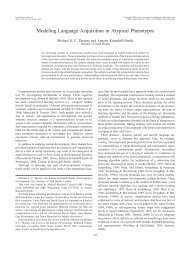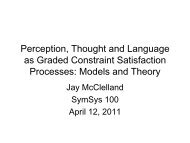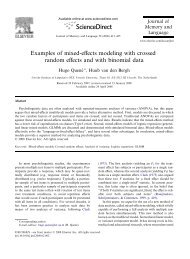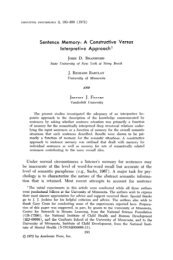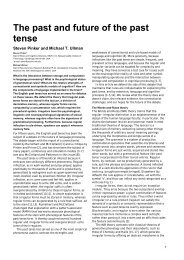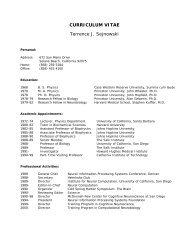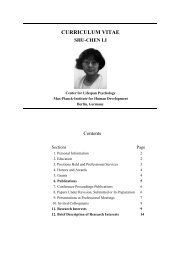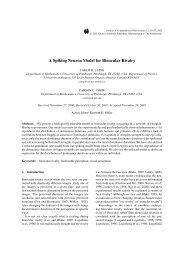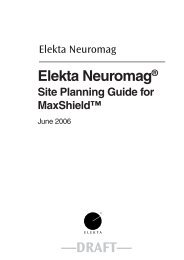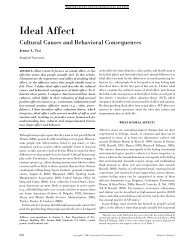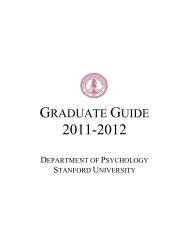Associated 'non-semantic' deficits in semantic dementia - Psychology
Associated 'non-semantic' deficits in semantic dementia - Psychology
Associated 'non-semantic' deficits in semantic dementia - Psychology
Create successful ePaper yourself
Turn your PDF publications into a flip-book with our unique Google optimized e-Paper software.
‘Pre-Semantic’ Cognition <strong>in</strong> Semantic Dementia:Six Deficits <strong>in</strong> Search of an ExplanationKaralyn Patterson 1 , Matthew A. Lambon Ralph 2 , Elizabeth Jefferies 2 ,Anna Woollams 1 , Roy Jones 3 , John R. Hodges 1 , Timothy T. Rogers 11 MRC Cognition & Bra<strong>in</strong> Sciences Unit, Cambridge UK2 University of Manchester, Manchester UK3 St Mart<strong>in</strong>’s Hospital, Bath UKCorrespondence to:Karalyn Patterson or Timothy T. RogersMRC Cognition & Bra<strong>in</strong> Sciences UnitDept of <strong>Psychology</strong>15 Chaucer Road University of Wiscons<strong>in</strong>Cambridge CB2 2EF Madison, WI 5370601223 355294 (tel) 608-262-0808 (tel)01223 359062 (fax) 608-252-4029 (fax)karalyn.patterson@mrc-cbu.cam.ac.ukttrogers@wisc.edu1
“Oh, sir, you must be well aware that life is full of endless absurdities which do not even have to appearplausible, s<strong>in</strong>ce they are true”. From Six Characters <strong>in</strong> Search of an Author, by Luigi Pirandello (1921)AbstractOn the basis of a theory about the role of <strong>semantic</strong> knowledge <strong>in</strong> the recognition and production offamiliar words and objects, we predicted that patients with <strong>semantic</strong> <strong>dementia</strong> would reveal aspecific pattern of impairment on six different tasks typically considered ‘pre-’ or ‘non-’ <strong>semantic</strong>:read<strong>in</strong>g aloud, writ<strong>in</strong>g to dictation, <strong>in</strong>flect<strong>in</strong>g verbs, lexical decision, object decision, and delayedcopy draw<strong>in</strong>g. The prediction was that all tasks would reveal a frequency-by-typicality <strong>in</strong>teraction,with patients perform<strong>in</strong>g especially poorly on lower-frequency items with atypical structure (e.g.words with an atypical spell<strong>in</strong>g-to-sound or sound-to-spell<strong>in</strong>g relationship; objects with an atypicalfeature for their class, such as the hump on a camel; etc). Of 84 critical observations (14 patientsperform<strong>in</strong>g six tasks), this prediction was correct <strong>in</strong> 84/84 cases, and a s<strong>in</strong>gle component <strong>in</strong> a factoranalysis accounted for 87% of the variance across tasks. Errors also consistently conformed to thepredicted pattern for both expressive and receptive tasks, with responses reflect<strong>in</strong>g residualknowledge about the typical surface structure of each doma<strong>in</strong>. We argue that these results cannotbe expla<strong>in</strong>ed as associated but unrelated <strong>deficits</strong> but <strong>in</strong>stead are a pr<strong>in</strong>cipled consequence of aprimary <strong>semantic</strong> impairment.(191 words)2
familiarity words or pictures with atypical form or structure, on the other hand, accuracy tends tobe significantly below normal. Furthermore, <strong>in</strong> the four of these six tasks that require production(read<strong>in</strong>g aloud, spell<strong>in</strong>g to dictation, past-tense verb <strong>in</strong>flection, delayed copy of object draw<strong>in</strong>gs),the errors also follow a specific and common pattern: relative to the <strong>in</strong>tended targets, the patients’responses are more typical or ‘regularised’ (Rogers et al., 2004b).The question addressed <strong>in</strong> this article is how best to account for these additional features ofthe cognitive profile of <strong>semantic</strong> <strong>dementia</strong>. One theoretically un<strong>in</strong>spir<strong>in</strong>g but neverthelesscritically important hypothesis is that these are associated but unrelated <strong>deficits</strong>. For example,when an SD patient is <strong>in</strong>vited to read aloud a written word with an atypical spell<strong>in</strong>g-soundcorrespondence (like sew <strong>in</strong> English), and mispronounces it <strong>in</strong> a more typical fashion (sew “sue”, rhym<strong>in</strong>g with new), this might <strong>in</strong>dicate dysfunction <strong>in</strong> a bra<strong>in</strong> region needed to compute thepronunciation of words with atypical spell<strong>in</strong>g-sound correspondences that is <strong>in</strong>dependent of theneurological abnormality caus<strong>in</strong>g the patient’s <strong>semantic</strong> deficit. Likewise, when an SD patientperforms two-alternative forced choice object decision and selects the picture of a camel without ahump as the real th<strong>in</strong>g <strong>in</strong> preference to the humped camel (Rogers et al., 2004a), such errors couldreflect abnormality <strong>in</strong> the bra<strong>in</strong> region represent<strong>in</strong>g pre-<strong>semantic</strong> structural descriptions of familiarobjects, aga<strong>in</strong> separate from the atrophy caus<strong>in</strong>g the deterioration of conceptual knowledge. Thesix processes <strong>in</strong> focus here are rather disparate <strong>in</strong> the sense that they <strong>in</strong>clude four verbal and twononverbal tasks, and also comprise two that require only recognition of words or objects and fourthat <strong>in</strong>volve output <strong>in</strong> the form of word production or draw<strong>in</strong>g. As a consequence, it is unlikely thatall six of these abilities would be disrupted by impairment to a s<strong>in</strong>gle additional non-<strong>semantic</strong>cognitive function. The ma<strong>in</strong> alternative <strong>in</strong>terpretations, therefore, seem to be either (i) that thesesix associated <strong>deficits</strong> are expla<strong>in</strong>ed by disruptions to a number of different additional cognitivesub-systems, or (ii) that all of the <strong>deficits</strong> can be <strong>in</strong>terpreted as a pr<strong>in</strong>cipled consequence of the4
primary <strong>semantic</strong> degradation. For the sake of brevity, we shall refer to these two positions asABUD (<strong>Associated</strong> But Unrelated Deficits) and IAS (It’s All Semantic).This article presents a case for IAS. We beg<strong>in</strong> with data from 14 patients with <strong>semantic</strong><strong>dementia</strong>, all of whom were tested on all six of these tasks. As mentioned above, there is alreadyevidence <strong>in</strong> the literature for impairment <strong>in</strong> each of these six abilities <strong>in</strong> patients with SD; but apartfrom the fact that a greater accumulation of evidence is generally desirable, the IAS accountrequires more data for the follow<strong>in</strong>g pr<strong>in</strong>cipal reason: the demonstrations of each of theseimpairments have largely applied to <strong>in</strong>dependent groups of SD patients. A proponent of ABUDmight argue that the three SD patients shown to be impaired on delayed copy draw<strong>in</strong>g <strong>in</strong> Bozeat etal. (2003) happened to have additional damage to bra<strong>in</strong> regions crucial for visual structuraldescriptions of objects, but that other SD patients would not be so characterised. Likewise, the sixSD patients <strong>in</strong> Patterson and Hodges (1992) with <strong>deficits</strong> <strong>in</strong> read<strong>in</strong>g words with irregular spell<strong>in</strong>gsoundcorrespondences might co<strong>in</strong>cidentally have had structural or functional lesions to the lexicalroute for read<strong>in</strong>g. As there was no overlap between the patients participat<strong>in</strong>g <strong>in</strong> these two studies,the current literature does not reveal whether the three cases <strong>in</strong> Bozeat et al. (2003) had read<strong>in</strong>g<strong>deficits</strong> like the patients <strong>in</strong> Patterson and Hodges (1992), nor whether the six cases <strong>in</strong> the read<strong>in</strong>gstudy would have had trouble <strong>in</strong> delayed copy<strong>in</strong>g of objects with atypical features. This concernmay seem to have less force when, as <strong>in</strong> Rogers et al. (2004a), 21 of 22 SD patients tested forlexical decision were found to be impaired. Even here, however, because one of the 22 cases wasat the bottom of the normal range on low-frequency atypical words, and because this particularpatient was not tested on all of the other abilities of <strong>in</strong>terest here, a proper evaluation of the twohypotheses is not possible on the basis of exist<strong>in</strong>g data.The pr<strong>in</strong>cipal f<strong>in</strong>d<strong>in</strong>gs of the study will be reported <strong>in</strong> three sections deal<strong>in</strong>g with: (1) thepatients’ accuracy on the four conditions of each of the six tasks relative to control data for thesame test; (2) the patients’ error types <strong>in</strong> the four production tasks (the two receptive tasks were5
oth two-alternative forced choice, mean<strong>in</strong>g that the only errors that a subject could make were thechoices selected by the experimenters); (3) the relationship of each patient’s performance on thesix tasks to his or her degree of <strong>semantic</strong> decl<strong>in</strong>e.The strongest statements of our predictions with respect to these three aspects of the resultsare as follows: (1) The patients should be impaired on every one of the tasks, with the pattern ofimpairment always characterised by a frequency x typicality <strong>in</strong>teraction favour<strong>in</strong>g frequent and/orregular items. (2) The great majority of the patients’ errors <strong>in</strong> productive tasks should be‘legitimate’ errors. That is, they should be composed of elements that are legitimate forcomponents of the stimulus <strong>in</strong> other contexts, and hence reflect the patients’ residual knowledge oftypical structure for the relevant doma<strong>in</strong>. In the productive verbal tasks, for example, this wouldmean pronounc<strong>in</strong>g ‘blood’ to rhyme with ‘food’ (or perhaps ‘good’); spell<strong>in</strong>g ‘yacht’ the way itsounds, e.g. ‘yot’; or add<strong>in</strong>g ‘-ed’ to the stem to form the past-tense of ‘th<strong>in</strong>k’. In each case, theresponse is <strong>in</strong>correct for the particular item, but is correct for other items that share componentswith the target item. Similarly <strong>in</strong> delayed-copy draw<strong>in</strong>g, errors should reflect residual knowledgefor typical structure of items <strong>in</strong> the doma<strong>in</strong>. For <strong>in</strong>stance, participants should omit idiosyncraticfeatures such as the stripes of a zebra, s<strong>in</strong>ce most items that share components with the zebra (legs,eyes, etc) do not have stripes; but properties that the zebra shares with other animals should tend tobe preserved. (3) Individual levels of accuracy on the irregular stimuli <strong>in</strong> all tasks should bemodulated by the patient’s degree of <strong>semantic</strong> deterioration as <strong>in</strong>dexed by our composite <strong>semantic</strong>score.ResultsAccuracy. Figure 1 displays the proportion of correct responses <strong>in</strong> the six experimentaltasks. Each panel <strong>in</strong> the composite figure corresponds to one task, and each panel <strong>in</strong>dicates (a) therange of control performance (shown as pale grey rectangles) for each of the four conditionscreated by cross<strong>in</strong>g frequency or familiarity with regularity or typicality (operationally def<strong>in</strong>ed for6
each task <strong>in</strong> the Methods section); and (b) the mean and 90% confidence <strong>in</strong>tervals of the SDpatients’ performance, separately for the half of the patient group with milder <strong>semantic</strong> impairmentand the half with more severe <strong>semantic</strong> degradation. For the two receptive tasks, lexical decisionand object decision, which were both presented <strong>in</strong> a 2AFC paradigm, chance-level performance(0.5) is <strong>in</strong>dicated by a dashed l<strong>in</strong>e. For the draw<strong>in</strong>g task, control performance is marked as 100% <strong>in</strong>all conditions, because only the features of the draw<strong>in</strong>gs produced by every control subject wereused as the basel<strong>in</strong>e aga<strong>in</strong>st which to evaluate the patients’ performance.--Figure 1 about here--Control subjects performed all of these tasks with relative ease and with only a modestimpact of frequency and typicality on their accuracy. We have not superimposed control means onthe control performance range <strong>in</strong> Figure 1 so as to avoid clutter; but <strong>in</strong> every task, controlperformance averaged ≥95% correct, even <strong>in</strong> the most difficult condition with low-frequencyirregular targets. For the two receptive tasks (lexical and object decision), control means andvariances were equivalent for regular and irregular items <strong>in</strong> both frequency conditions.The patients’ performance, by contrast, was markedly affected by condition <strong>in</strong> each of thesetasks. For the six low-frequency irregular conditions, the 90% confidence <strong>in</strong>tervals for both themilder and the more <strong>semantic</strong>ally impaired subgroup were substantially below the control range.Note that, <strong>in</strong> this condition of the two 2AFC tasks, the confidence <strong>in</strong>tervals for the most<strong>semantic</strong>ally impaired cases <strong>in</strong>clude chance level for object decision and are entirely below chancefor lexical decision. In other words, as demonstrated previously by Rogers et al. (2004a), patientswith profoundly degraded conceptual knowledge often select nonwords <strong>in</strong> preference to lowerfrequencyreal words <strong>in</strong> lexical decision if the nonword <strong>in</strong> the pair has a more typical orthographicstructure than the word (example: khaki/kackey).For all six tasks, we predicted a frequency-by-typicality effect on the patients’ accuracy;how did this prediction fare? The results of a series of six ANOVA’s, each with two with<strong>in</strong>-subject7
esponse rhym<strong>in</strong>g with “good” is also treated as a LARC error. One of the advantages of theLARC classification is that it can also encompass many of the errors that patients make to regularwords, as for example when a patient pronounces the written word hoot to rhyme with “foot”. Thethird response type <strong>in</strong> Figure 2 is anyth<strong>in</strong>g other than a correct response or a LARC error.--Figure 2 about here--The strik<strong>in</strong>g commonality of the three panels <strong>in</strong> Figure 2 is that, as one moves across thefour stimulus conditions <strong>in</strong> each task, the proportion of responses correspond<strong>in</strong>g to LARC errors<strong>in</strong>creases monotonically, and there is a gradual trade-off between correct responses and LARCerrors. For the high-frequency regular conditions, the majority of responses were correct and thusof course there were scarcely any LARC errors. By contrast, once the patients were required tograpple with low-frequency irregular targets, LARC errors were as likely as (for read<strong>in</strong>g and verb<strong>in</strong>flection), or (for spell<strong>in</strong>g) even substantially more likely than, correct responses. Low-frequencyregular and high-frequency irregular targets engendered ratios of correct/LARC responses <strong>in</strong>between the easiest and more difficult conditions, and the degree of trade-off varied with the task.The other important th<strong>in</strong>g to note <strong>in</strong> Figure 2 is that non-LARC “Other” errors did not <strong>in</strong>creasemonotonically across the four conditions of any of the three tasks. There was a trend towards more“Other” errors for the low- than the high-frequency targets, but no h<strong>in</strong>t of <strong>in</strong>creased “Other” errors<strong>in</strong> the irregular relative to the regular conditions. The only additional po<strong>in</strong>t of <strong>in</strong>terest about the“Other” errors is their somewhat higher <strong>in</strong>cidence <strong>in</strong> the verb-<strong>in</strong>flection task relative to read<strong>in</strong>g andeven to spell<strong>in</strong>g. This is because one type of “Other” error occurred <strong>in</strong> the past-tense verb task thatcannot occur <strong>in</strong> read<strong>in</strong>g or spell<strong>in</strong>g: exact reproduction of the stimulus. In read<strong>in</strong>g, subjects musttranslate from orthography to phonology to respond, and <strong>in</strong> spell<strong>in</strong>g they must do the reverse; but<strong>in</strong> the verb task, if they do not know how to transform the verb from its stem form to its past-tenseform, they can and sometimes do simply repeat the stem form that they have just heard (e.g.“Today I buy a newspaper; yesterday I buy a newspaper”).9
The results of the error analysis for the rema<strong>in</strong><strong>in</strong>g production task, delayed copy draw<strong>in</strong>g,are depicted <strong>in</strong> Figure 3. The left half of the figure shows the mean proportion of shared anddist<strong>in</strong>ctive features omitted by the patients, tabulated separately for the milder and more severepatient subsets. In both, dist<strong>in</strong>ctive features were much more likely to be omitted than sharedfeatures, with the more severe group omitt<strong>in</strong>g more features overall. The right side of the graphshows the mean proportion of <strong>in</strong>trusions amongst shared and dist<strong>in</strong>ctive features. Note that, bydef<strong>in</strong>ition, there are few opportunities for shared properties to <strong>in</strong>trude: these properties tend to becommon to <strong>semantic</strong>ally related items, and thus can only be <strong>in</strong>correctly added to the few items <strong>in</strong> acategory that do not happen to share them. We therefore tabulated the <strong>in</strong>trusions by tak<strong>in</strong>g thenumber of shared or dist<strong>in</strong>ctive <strong>in</strong>trusions for each item, and divid<strong>in</strong>g this by the total number ofopportunities for <strong>in</strong>trusion across shared and dist<strong>in</strong>ctive properties for that item. The results showthat <strong>in</strong>trusions are proportionately much more likely to occur for shared than for dist<strong>in</strong>ctiveproperties, <strong>in</strong> both the milder and more severe subgroups. Thus <strong>in</strong> summary, visual properties thatdist<strong>in</strong>guish an item from its category neighbours are likely to be omitted, whereas visual propertiesthat typify a given doma<strong>in</strong> are likely to be added to the few doma<strong>in</strong> members that do not sharethem.--Figure 3 about here--Relationship to <strong>semantic</strong> deficit. Figure 4 displays (<strong>in</strong> six separate panels, one for eachtask) the plot of every patient’s composite <strong>semantic</strong> score aga<strong>in</strong>st his or her proportion of correctresponses on the irregular target items <strong>in</strong> the relevant task. High- and low-frequency irregular itemshave been comb<strong>in</strong>ed here, for two reasons. First, for some tasks (especially spell<strong>in</strong>g), there werenot many items per frequency condition, such that <strong>in</strong>clud<strong>in</strong>g both frequency bands provides a morestable estimate of performance. Secondly, some of the patients’ scores on the lower-frequencyirregular items <strong>in</strong> one or more tasks were virtually at floor; <strong>in</strong>clud<strong>in</strong>g the higher-frequencyirregular items yielded a better range of scores to correlate with <strong>semantic</strong> status.10
At the top of each panel, beside the task label, is the correlation between the values on theX and Y axes. In four of the six tasks, two different correlation values are provided: these refer tothe r-value with/without the data po<strong>in</strong>ts <strong>in</strong> the panel represented by symbols other than a circle.These are so-called ‘high-<strong>in</strong>fluence’ data po<strong>in</strong>ts, with a Cook’s distance ≥0.3 (or approximately4/(n-k-1) where k is the number of <strong>in</strong>dependents; see Fox, 1991), whose <strong>in</strong>clusion/exclusion altersthe fit of the regression model to the rema<strong>in</strong><strong>in</strong>g data po<strong>in</strong>ts. The regression l<strong>in</strong>e <strong>in</strong> each panel is theleast-squares fit exclud<strong>in</strong>g the high-<strong>in</strong>fluence po<strong>in</strong>ts.Figure 4 about hereThere were no high-<strong>in</strong>fluence data po<strong>in</strong>ts for read<strong>in</strong>g, so there is only one r-value here: thecorrelation between composite <strong>semantic</strong> score and read<strong>in</strong>g irregular words was r=0.81. There weretwo deviant scores for verb <strong>in</strong>flection: <strong>in</strong> both, the patient’s success <strong>in</strong> <strong>in</strong>flect<strong>in</strong>g irregular verbswas worse than would be expected on the basis of his (LS) or her (JTh) <strong>semantic</strong> impairment. Forspell<strong>in</strong>g and lexical decision, there was one high-<strong>in</strong>fluence data po<strong>in</strong>t each: patient JP, the least<strong>semantic</strong>ally impaired case of the 14 by the composite measure, had lower scores than predicted onthese two tasks. There were no such po<strong>in</strong>ts for object decision, the task that yielded the lowestcorrelation with composite <strong>semantic</strong> score. Some of the data po<strong>in</strong>ts for object decision seemconsiderably above or below the regression l<strong>in</strong>e, but because the cluster<strong>in</strong>g around this l<strong>in</strong>e waslooser <strong>in</strong> this task than the other five, the analysis did not identify any po<strong>in</strong>ts with a Cook’sdistance ≥0.3. For draw<strong>in</strong>g, there were two deviant cases: LS was poorer than predicted for his(relatively mild) degree of <strong>semantic</strong> deficit, and WM produced better delayed copy draw<strong>in</strong>gs thanexpected for her (relatively severe) <strong>semantic</strong> decl<strong>in</strong>e. Summaris<strong>in</strong>g across tasks, by this method ofanalys<strong>in</strong>g the results, there was only one <strong>in</strong>stance out of a possible 84 (14 patients x 6 tasks) wherea patient’s performance on irregular items (WM for delayed copy draw<strong>in</strong>g) significantly exceeded11
the level of performance predicted by her degree of <strong>semantic</strong> deficit. In 5/84 cases (all deriv<strong>in</strong>gfrom three patients), the level of success was significantly lower than predicted.The preced<strong>in</strong>g paragraph dealt with this relationship for each task across the 14 patients,but another way of address<strong>in</strong>g this issue that is germane to our hypothesis is to exam<strong>in</strong>e therelationship for each patient across the six tasks. This can be seen <strong>in</strong> Table 2, where the patients arelisted from least to most <strong>semantic</strong>ally impaired by the composite measure. In the six columns ofthe table identified by task label, the symbols signify as follows: a back-slash means that thepatient’s score for that task falls exactly on or barely off the regression l<strong>in</strong>e; a s<strong>in</strong>gle m<strong>in</strong>us or plus<strong>in</strong>dicates that the patient’s score is a little below or above the regression l<strong>in</strong>e; a double m<strong>in</strong>us orplus means that the pert<strong>in</strong>ent score is a larger distance below or above the l<strong>in</strong>e, but not significantlyso; and a triple m<strong>in</strong>us or plus corresponds to a high-<strong>in</strong>fluence data po<strong>in</strong>t with a Cook’s distance of≥0.3. With the exception of JP, whose scores on the six tasks were consistently somewhat belowthe values predicted by his composite <strong>semantic</strong> score, every patient had a majority of scores thatwere either on (\) or very near (+ or -) the regression l<strong>in</strong>e. There is not much <strong>in</strong> the way of coherentpattern to the subset of tasks on which each patient performed better or less well than predicted,with perhaps three exceptions: AN, whose temporal atrophy is left-dom<strong>in</strong>ant, achieved scores at orbelow predicted levels for the four verbal tasks but mildly better than predicted for the two visualtasks. WM – with the exception of lexical decision – showed an even stronger version of AN’spattern. She is noteworthy by virtue of the fact that her atrophy is still highly asymmetrical (andleft-dom<strong>in</strong>ant) after 6+ years of the disease, at a stage when the atrophy is typically extensive onboth sides. F<strong>in</strong>ally, BS, whose temporal atrophy is right-dom<strong>in</strong>ant, showed someth<strong>in</strong>g like thereverse pattern to AN and WM, with better-than-expected scores on all of the verbal tasks andlower-than-expected values on the two visual tasks. These patterns make some sense <strong>in</strong> terms ofclassical hemispheric division of labour.--Table 2 about here--12
As a third means of understand<strong>in</strong>g the relationship between a patient’s degree of <strong>semantic</strong>impairment and his/her performance on the 6 ‘pre-<strong>semantic</strong>’ tasks, we entered all of the scoresshown <strong>in</strong> Figure 4 – proportion correct for “irregular” items <strong>in</strong> each task, along with the composite<strong>semantic</strong> score for each patient – <strong>in</strong>to an exploratory factor analysis. If certa<strong>in</strong> of the tests patternreliably together, over and above their correlation with <strong>semantic</strong> impairment, the factor analysisshould <strong>in</strong>dicate that two or more components contribute significantly to the covariance matrix forthese seven measures. The analysis was performed on the covariance matrix derived from the rawdata, s<strong>in</strong>ce no task deviated reliably from normal. Pr<strong>in</strong>cipal components with an eigenvalueexceed<strong>in</strong>g the mean were accepted <strong>in</strong> the f<strong>in</strong>al solution. The algorithm found a s<strong>in</strong>gle componentaccount<strong>in</strong>g for 87% of the variance across the seven measures. The next-largest eigenvalue was anorder of magnitude smaller than the first, <strong>in</strong>dicat<strong>in</strong>g that little non-random variance rema<strong>in</strong>ed to beexpla<strong>in</strong>ed <strong>in</strong> the data once the first component was considered.DiscussionThis study had two purposes. The empirical goal was to demonstrate that a s<strong>in</strong>gle group ofSD patients would have a specific pattern of impairment <strong>in</strong> six different ‘pre-<strong>semantic</strong>’ processes;all of these processes have previously been reported to be impaired <strong>in</strong> SD, but never concurrently,i.e. a s<strong>in</strong>gle set of patients reveal<strong>in</strong>g all <strong>deficits</strong>. Predicated on the assumption of a positiveoutcome for the empirical purpose, the theoretical goal was to use this data set to argue for an IASrather than an ABUD <strong>in</strong>terpretation of the f<strong>in</strong>d<strong>in</strong>gs. As a rem<strong>in</strong>der, IAS (It’s All Semantic) isshort-hand for the hypothesis that the six impairments are caused by the central <strong>semantic</strong>deterioration. ABUD (<strong>Associated</strong> But Unrelated Deficits) is short-hand for the alternative proposalthat there is no causal l<strong>in</strong>k between a patient’s <strong>semantic</strong> status and his or her impairment <strong>in</strong> verb<strong>in</strong>flection or lexical decision or delayed copy draw<strong>in</strong>g etc.The ABUD view seems to be based on the follow<strong>in</strong>g comb<strong>in</strong>ation of theoretical pr<strong>in</strong>ciplesand empirical observations. The theoretical view is that the modularity of the normal cognitive13
architecture enables all of these six tasks to be accomplished without reference to <strong>semantic</strong><strong>in</strong>formation about the words or objects be<strong>in</strong>g processed. Words are translated from orthography tophonology (read<strong>in</strong>g aloud) or from phonology to orthography (spell<strong>in</strong>g to dictation) by lexicaland/or non-lexical procedures <strong>in</strong> which word mean<strong>in</strong>g plays no significant part (Coltheart, Rastle,Perry, Langdon, & Ziegler, 2001). Past-tense forms of verbs are generated from their stem formson the basis of morphological rules (if the verbs have regular <strong>in</strong>flections) or lexical associativeknowledge (if they are irregular), and aga<strong>in</strong> these are apparently considered to be pre- or extra<strong>semantic</strong>procedures (P<strong>in</strong>ker, 1999; Tyler et al., 2004). Acceptance of a word (<strong>in</strong> lexical decision)or picture (<strong>in</strong> object decision) as real/familiar requires only contact with the appropriate node <strong>in</strong> anorthographic lexicon or structural description system, each of which precedes and <strong>in</strong>deed is agateway to conceptual knowledge about the word or object (Coltheart, 2004; Riddoch &Humphreys, 1987). Delayed copy draw<strong>in</strong>g of familiar objects, of which there is far less discussion<strong>in</strong> the literature, presumably depends only on the structural description system plus visual shorttermmemory.The empirical evidence for ABUD stems from case studies of patients with <strong>semantic</strong>impairments who perform normally on one or more of the various ‘extra’-<strong>semantic</strong> tasksconsidered here. We will consider exceptional case studies and their implications for ABUD andIAS <strong>in</strong> further detail below. Here we simply note that, for proponents of ABUD, such casesconclusively refute the hypothesis that extra-<strong>semantic</strong> <strong>deficits</strong> <strong>in</strong> SD are caused by an underly<strong>in</strong>g<strong>semantic</strong> impairment. On this view, if good performance can obta<strong>in</strong> on such tasks when <strong>semantic</strong>knowledge is degraded, even for N = 1 case, there can be no causal l<strong>in</strong>k between <strong>semantic</strong>impairment and extra-<strong>semantic</strong> <strong>deficits</strong>—no matter how large the N of cases demonstrat<strong>in</strong>g anassociation (see e.g. Coltheart, 2004). The association is treated as a co<strong>in</strong>cidence aris<strong>in</strong>g fromconcurrent damage to functionally unrelated bra<strong>in</strong> regions.14
The argument for IAS and aga<strong>in</strong>st ABUD <strong>in</strong> this paper is based on three critical outcomesfrom the current set of results. (i) We have obta<strong>in</strong>ed a set of 84 observations <strong>in</strong> a low-frequencyirregular condition (14 patients x 6 tasks) for which we predicted impaired performance, and thisprediction was correct <strong>in</strong> 84/84 cases. It is important to reiterate that these six tasks are fairlydisparate <strong>in</strong> the non-<strong>semantic</strong> processes that they require. Indeed, <strong>in</strong> a few cases, it might bedifficult to argue that a pair of the tasks, such as s<strong>in</strong>gle-word read<strong>in</strong>g and delayed copy draw<strong>in</strong>g, orwritten-word lexical decision and spoken past-tense verb <strong>in</strong>flection, would have any non-<strong>semantic</strong>components <strong>in</strong> common. Yet all 14 patients had abnormal performance on low-frequency atypicalitems <strong>in</strong> both of these pairs of dissimilar tasks, as well as all the rema<strong>in</strong><strong>in</strong>g tasks. (ii) The specificpattern of the impairment was the same across tasks, not only <strong>in</strong> terms of which items arevulnerable but also – for the four tasks <strong>in</strong>volv<strong>in</strong>g free production – <strong>in</strong> terms of the types of errorsthat the patients made. (iii) We also have 84 observations of the correspondence between eachpatient’s performance on irregular items and his or her concurrent level of <strong>semantic</strong> degradation.Of these, only 1/84 represents performance that significantly alters the fit of the regression modelwhen <strong>in</strong>cluded and reflects better than expected performance given the level of <strong>semantic</strong>impairment.Our challenges to ABUD on the basis of these three outcomes are as follows. (i) At thisstage of knowledge <strong>in</strong> our field, we have only tentative hypotheses about the neuroanatomicalregions required for performance of these six tasks, and <strong>in</strong>deed about the region(s) <strong>in</strong>volved <strong>in</strong> therepresentation of conceptual knowledge. Nevertheless, we ask how likely it is that the spread ofatrophy outwards from the temporal pole, where the pathological process <strong>in</strong> SD almost <strong>in</strong>variablybeg<strong>in</strong>s, would happen to affect the disparate sites required for all six tasks <strong>in</strong> every patient. (ii)Even if the answer to (i) were “not impossible”, we ask how likely it is that the pattern ofimpairment across all tasks would be so similar, with accuracy always characterised by afrequency-by-typicality <strong>in</strong>teraction and errors almost always more typical of the doma<strong>in</strong> than the15
target. If these <strong>deficits</strong> were only accidentally associated with, and truly unrelated to, the <strong>semantic</strong>dis<strong>in</strong>tegration, then why, for example, don’t some patients have phonological rather than surfacedyslexia? Or, if they make mistakes <strong>in</strong> 2AFC lexical decision, why don’t a few of them reveal thepattern demonstrated <strong>in</strong> Rogers et al. (2004a) for stroke patients with Broca’s aphasia, who wereimpaired <strong>in</strong> the task and worse for low-frequency targets, but were completely unaffected by theorthographic typicality manipulation? (iii) As a k<strong>in</strong>d of extension of (i), how likely is it that thedegree of impairment <strong>in</strong> every task should be modulated by degree of <strong>semantic</strong> degradation?Suppose that the orthographic lexicon or visual word-form system, upon which written-wordlexical decision may be based (Coltheart, 2004), is located <strong>in</strong> the left occipitotemporal region(Dehaene, Le Clec’H, Pol<strong>in</strong>e, Le Bihan, & Cohen, 2002; McCandliss, Cohen, & Dehaene, 2003). Itis perhaps plausible that atrophy start<strong>in</strong>g <strong>in</strong> the anterior left temporal lobe might spread caudally toaffect BA37, such that an emerg<strong>in</strong>g deficit <strong>in</strong> lexical decision would co<strong>in</strong>cidentally correlate withan <strong>in</strong>creas<strong>in</strong>g <strong>semantic</strong> deficit (although this would not expla<strong>in</strong> the specific frequency-by-typicalitypattern observed here). But how would one also expla<strong>in</strong> that the same patient’s degree of <strong>semantic</strong>deficit concurrently predicts the degree of deficit <strong>in</strong> delayed copy draw<strong>in</strong>g? The non-<strong>semantic</strong>components of this task are probably a structural description system thought to be localised aroundthe right posterior temporal/<strong>in</strong>ferior parietal region (Gerlach, Law, Gade, & Paulson, 1999;Warr<strong>in</strong>gton & Taylor, 1973) and/or visuospatial short-term memory which might depend on lateralfrontal structures (Bor, Duncan, Wiseman, & Owen, 2003).IAS has an answer to each of these challenges, and it is more-or-less the same answer <strong>in</strong>each case (see Rogers et al., 2004b, for a more extensive description of this theory and itsimplementation <strong>in</strong> a connectionist network). The account proposes that, <strong>in</strong> addition to processesoccurr<strong>in</strong>g <strong>in</strong> many other parts of the bra<strong>in</strong> when these various tasks are performed, they all rely <strong>in</strong>common on <strong>in</strong>teraction with a <strong>semantic</strong> system <strong>in</strong> the anterior temporal lobes. This system does notrepresent conceptual content (e.g. that canaries are yellow or that knives can cut); it is, <strong>in</strong>stead, an16
abstract system that encodes higher-order relations amongst features and concepts. Theserepresentations are structured to enable generalisation amongst similar concepts, which is criticalfor learn<strong>in</strong>g and for respond<strong>in</strong>g to new tokens of familiar types, etc. Of equal importance, the<strong>semantic</strong> representations permit differentiation between similar concepts, which we need for othersorts of processes such as object nam<strong>in</strong>g or know<strong>in</strong>g that one k<strong>in</strong>d of mushroom is delicious andsafe to eat but another similar-look<strong>in</strong>g one is poisonous.Whereas the <strong>semantic</strong> system encodes representations that capture conceptual similaritystructure, the surface representations that encode <strong>in</strong>put to or output from <strong>semantic</strong>s capturestructure that is tailored to particular expressive or receptive doma<strong>in</strong>s. For <strong>in</strong>puts that are generallyconsistent with the surface structure <strong>in</strong> some modality—for <strong>in</strong>stance, ‘standard’ 4-legged, 2-eyed,2-eared, 1-tailed, humpless animals, or written words composed of typical bigrams and trigrams—such structure facilitates process<strong>in</strong>g: the correct surface representations can be computedpredom<strong>in</strong>antly through local <strong>in</strong>teractions, without much support from <strong>semantic</strong>s. Items that havemore idiosyncratic component features (e.g. words with <strong>in</strong>frequent letter comb<strong>in</strong>ations), or unusualrelationships to their representations <strong>in</strong> other doma<strong>in</strong>s (e.g. words with atypical pronunciations fortheir spell<strong>in</strong>gs), are not so well supported by with<strong>in</strong>-modality similarity structure, nor by<strong>in</strong>teraction with other surface forms; hence these items rely considerably more on <strong>in</strong>teractions withthe <strong>semantic</strong> system. These pr<strong>in</strong>ciples have been demonstrated <strong>in</strong> computational models of wordread<strong>in</strong>g(Plaut, McClelland, Seidenberg, & Patterson, 1996), past-tense formation (Joanisse &Seidenberg, 1999), and delayed-copy draw<strong>in</strong>g (Rogers et al., 2004a).Accord<strong>in</strong>gly, the IAS answers to the three challenges are as follows. (i) All six tasks areimpaired by atrophy conf<strong>in</strong>ed to the anterior temporal lobe because, <strong>in</strong> addition to all of thedisparate regions <strong>in</strong>volved <strong>in</strong> the non-<strong>semantic</strong> components of the tasks, all require <strong>in</strong>teraction withthis <strong>semantic</strong> system. (ii) Damage to this s<strong>in</strong>gle <strong>semantic</strong> system will have the same pattern ofimpact on all of these tasks – a frequency-by-typicality <strong>in</strong>teraction – because lower-frequency17
atypical items receive the least support from knowledge of modality-specific surface structure, andthus depend to a greater extent on support from <strong>semantic</strong>s. (iii) In addition to the frequency andtypicality of the <strong>in</strong>put, the best predictor of a patient’s success <strong>in</strong> all tasks will be his or her degreeof <strong>semantic</strong> degradation because none of the tasks is truly non- or pre-<strong>semantic</strong>.We acknowledge that there is evidence from SD, for at least a few of the six tasks, tosupport the view that these processes do not need <strong>in</strong>put from/<strong>in</strong>teraction with <strong>semantic</strong> knowledge<strong>in</strong> order to deliver correct responses, even for atypical lower-frequency stimuli. That is, there havebeen a few s<strong>in</strong>gle-case reports of SD patients who were not impaired at the task <strong>in</strong> question. Insome cases, it seems likely that the apparently spared performance derives from test materials thatwere not structured <strong>in</strong> the manner required to reveal the deficit. If the non-real objects <strong>in</strong> objectdecision are less typical than the real objects, for example, the patients will perform well, asillustrated <strong>in</strong> Figure 1 (and explored at greater length <strong>in</strong> Rogers et al., 2003, 2004a). In other cases,absence of a recorded deficit may simply derive from lack of power to detect it. Tyler et al. (2004)recently described four SD patients tested on a past-tense elicitation task similar to the onedescribed here, and reported perfect success for two of the patients on a set of 22 irregular verbs(13 higher frequency and 9 lower). As it happens, three of the four patients <strong>in</strong> Tyler et al., thoughonly one of the two with perfect scores on irregular verbs, also participated <strong>in</strong> our study at aroundthe same time. Tyler (personal communication) k<strong>in</strong>dly provided us with her materials: there aren<strong>in</strong>e specific past-tense irregular verbs (such as came, chose, drank) that appeared <strong>in</strong> both their setof 22 and our set of 50 irregular verbs. On these n<strong>in</strong>e overlapp<strong>in</strong>g items, there is no more than as<strong>in</strong>gle item of discrepancy <strong>in</strong> any of the three patients’ scores. In other words, although the resultsof the two studies seem to conflict, they do not; and the most likely reason for the apparentdiscrepancy is simply that our study employed more than twice as many items <strong>in</strong> the generalirregular set and nearly three times as many <strong>in</strong> the critical set of low-frequency irregular items,with a consequent greater sensitivity to detect<strong>in</strong>g a deficit.18
Nevertheless, there are a few reports of unimpaired performance on one of our six tasks, <strong>in</strong>s<strong>in</strong>gle cases of SD, that cannot be expla<strong>in</strong>ed by <strong>in</strong>sensitivity of the test. To our knowledge, threesuch cases exist for read<strong>in</strong>g aloud (Blazely, Coltheart, & Casey, Accepted; Cipolotti & Warr<strong>in</strong>gton,1995; Schwartz, Saffran, & Mar<strong>in</strong>, 1980) 1 , although WLP, the patient reported <strong>in</strong> Schwartz et al.,subsequently developed the pattern of surface dyslexic read<strong>in</strong>g predicted and reported <strong>in</strong> thecurrent manuscript. The literature also reports one SD case with unimpaired written-word lexicaldecision for materials that have been matched for orthographic typicality (Blazely et al.,Accepted). We are not aware of any conv<strong>in</strong>c<strong>in</strong>g demonstrations of preserved ability for the otherfour tasks, but they may be just around the corner. The question, of course, is whether these veryoccasional dissociations constitute critical evidence aga<strong>in</strong>st the IAS account of the overwhelm<strong>in</strong>gassociation. By traditional neuropsychological argument, the answer to this question is yes. Theclaim is that spurious associations can arise when otherwise unrelated cognitive functions happento depend upon neural structures that are jo<strong>in</strong>tly compromised <strong>in</strong> pathology—most likely becausethey are neuroanatomical neighbours. Dissociations, by contrast, are considered straightforwardlyto disprove causality.It will be obvious by now that, although this selective attention to dissociations is a widelyheld view, we do not share it. The processes that support word read<strong>in</strong>g, spell<strong>in</strong>g, draw<strong>in</strong>g, and soon, are complex and subject to many sources of variation, so that neuropathological conditionssuch as <strong>semantic</strong> <strong>dementia</strong> will produce a distribution of outcomes <strong>in</strong> these abilities. The currentdata document a strong population-level association between the extent of <strong>semantic</strong> impairmentand degree of deficit <strong>in</strong> each of tasks we have studied, but <strong>in</strong> no case is this relationship perfect:there is always variation around the regression l<strong>in</strong>e (see Lambon Ralph, 2004, and Lambon Ralph,1 Note that we are not <strong>in</strong>clud<strong>in</strong>g here a few reported cases of preserved read<strong>in</strong>g of irregular words comb<strong>in</strong>edwith ‘<strong>semantic</strong> impairment’ <strong>in</strong> Alzheimer’s disease or transcortical aphasia from stroke (e.g. Gerhand, 2001;Lambon Ralph, Ellis, & Frankl<strong>in</strong>, 1995). This is because we share the view of Silveri and Colosimo (1995)that <strong>semantic</strong> <strong>deficits</strong> measured (as they usually are) by multiple-item forced-choice tests like word-picture19
Moriarty, & Sage, 2002, for further discussion of this po<strong>in</strong>t). If this variation is distributednormally, and if a large enough sample is taken, then a small number of cases will fall <strong>in</strong> the uppertail of the distribution, perform<strong>in</strong>g better than expected given their level of <strong>semantic</strong> impairment; <strong>in</strong>the rare case, “better than expected” may even be with<strong>in</strong> the normal range. Although it is certa<strong>in</strong>lyimportant to work towards an understand<strong>in</strong>g of why a few <strong>in</strong>dividuals fall <strong>in</strong> the extremes of thedistribution, we nevertheless argue that selective emphasis on these exceptional cases is misguided,because it fails to expla<strong>in</strong> the majority of the evidence. As <strong>in</strong>dicated above, the undifferentiatedresponse of “accidental association due to anatomical proximity” is not an explanation for the datapresented here from tasks so varied that they must rely on far-flung bra<strong>in</strong> regions. A s<strong>in</strong>gle factor –presumably degree of <strong>semantic</strong> degradation – accounts for an impressively high 87% of thevariance <strong>in</strong> performance on both our <strong>semantic</strong> measures and our six cognitively and anatomicallydisparate ‘pre-<strong>semantic</strong>’ tasks. Our theory predicted not only this observed association but also theprecise pattern of the deficit obta<strong>in</strong>ed <strong>in</strong> all six tasks.In conclusion, the six <strong>deficits</strong> or ‘characters’ search<strong>in</strong>g for an explanation <strong>in</strong> this play havefound one: they are grouped <strong>in</strong>to one story by a s<strong>in</strong>gle, <strong>semantic</strong> author.MethodsParticipants. The SD cohort consisted of 14 patients who were <strong>in</strong>itially seen by a seniorneurologist/physician and a cl<strong>in</strong>ical neuropsychologist <strong>in</strong> UK hospital cl<strong>in</strong>ics <strong>in</strong> either Cambridgeor Bath. In addition to a cl<strong>in</strong>ical and neurological assessment, each patient was given a number ofstandard psychiatric rat<strong>in</strong>g scales to exclude major psychiatric disorders such as depression andschizophrenia, as well as structural bra<strong>in</strong> imag<strong>in</strong>g and the usual battery of screen<strong>in</strong>g blood tests toexclude treatable causes of <strong>dementia</strong>. All patients fulfilled the <strong>in</strong>ternational consensus and localmatch<strong>in</strong>g can significantly over-estimate the <strong>semantic</strong> impairment <strong>in</strong> cases with these aetiologies becausethese patients have difficulty select<strong>in</strong>g amongst multiple alternatives.20
criteria for <strong>semantic</strong> <strong>dementia</strong> (Hodges, Patterson, Oxbury, & Funnell, 1992; Neary et al., 1998):impaired receptive and expressive content-word vocabulary and impoverished <strong>semantic</strong>knowledge, with relative preservation of non-verbal reason<strong>in</strong>g, visuo-spatial abilities, phonology,syntax and day-to-day memory, plus structural bra<strong>in</strong> imag<strong>in</strong>g reveal<strong>in</strong>g focal atrophy <strong>in</strong> anterior,<strong>in</strong>ferior regions of the temporal lobe. Each of these cases has already been <strong>in</strong>cluded <strong>in</strong> anotherpublication on SD (for example, all were amongst the 22 cases <strong>in</strong> Rogers at al., 2004a), so we havenot provided detailed descriptions. Demographic characteristics and some basic backgroundneuropsychological data are given <strong>in</strong> Table 3. In the table, the patients are listed <strong>in</strong> the order fromleast (JP) to most (JG) <strong>semantic</strong>ally impaired as measured by a composite <strong>semantic</strong> score whichappears <strong>in</strong> the last column of Table 3; its calculation is described below.--Table 3 about here--In Table 3: Sex and age are self-explanatory. Scores on the M<strong>in</strong>i-Mental State Exam<strong>in</strong>ation(maximum=30) are given as an <strong>in</strong>dication of general cognitive status, and scores on copy<strong>in</strong>g thecomplex Rey Figure (maximum=36) are <strong>in</strong>cluded to <strong>in</strong>dicate that none of the patients had a visuospatialdeficit. The next three tests, on which normal <strong>in</strong>dividuals score essentially perfectly, areones always used <strong>in</strong> our research as assessments of <strong>semantic</strong> memory: nam<strong>in</strong>g of l<strong>in</strong>e draw<strong>in</strong>gs offamiliar objects for the 64 items <strong>in</strong> the Cambridge <strong>semantic</strong> battery; spoken word-to-picturematch<strong>in</strong>g (WPM) on the same 64 items, where the response arrays consist of the target picturealong with 9 other objects from the same <strong>semantic</strong> category; and the all-picture version of thePyramids & Palm Trees (PPTp) test of associative <strong>semantic</strong> knowledge (Howard & Patterson,1992). For eleven patients, all three <strong>semantic</strong> measures were taken with<strong>in</strong> six months of test<strong>in</strong>g onthe six tasks of <strong>in</strong>terest here. For the rema<strong>in</strong><strong>in</strong>g three patients, test<strong>in</strong>g on the six central tasksoccurred <strong>in</strong> between two regular (approximately yearly) longitud<strong>in</strong>al assessments on the <strong>semantic</strong>battery; for these patients, a more time-appropriate estimated score on each of the three <strong>semantic</strong>21
measures was created by averag<strong>in</strong>g the scores from the test<strong>in</strong>g rounds immediately preced<strong>in</strong>g andfollow<strong>in</strong>g the time of the experimental test<strong>in</strong>g.Scores on the three <strong>semantic</strong> tests were used to create an estimate of each patient’s degreeof deterioration <strong>in</strong> conceptual knowledge. Of these tests, nam<strong>in</strong>g is most sensitive to mild <strong>semantic</strong>impairment, whereas WPM and PPTp are more sensitive to moderate and severe impairment at apo<strong>in</strong>t when object nam<strong>in</strong>g is often at floor. To derive a composite score <strong>in</strong>dex<strong>in</strong>g overall degree of<strong>semantic</strong> impairment, we conducted a factor analysis on the three <strong>semantic</strong> measures us<strong>in</strong>g SPSS.Given that none of the measures deviated significantly from normal (p > 0.05), the raw scores wereentered directly <strong>in</strong>to the analysis. Pr<strong>in</strong>cipal components were extracted from the covariance matrix,and vectors with eigenvalues exceed<strong>in</strong>g the mean were accepted <strong>in</strong> the f<strong>in</strong>al solution. The analysisyielded a s<strong>in</strong>gle factor that accounted for 84% of the variance <strong>in</strong> the three tests, and the eigenvalueof the second component was an order of magnitude smaller than the first. In other words, acommon underly<strong>in</strong>g factor accounts for most of the variance and covariance among the three<strong>semantic</strong> tests, with additional factors provid<strong>in</strong>g little explanatory power. Scores on the s<strong>in</strong>glecomposite <strong>semantic</strong> factor were then calculated for each of the 14 patients (see the last column ofTable 3). The composite score has a mean of zero and unit variance, so that positive values <strong>in</strong>dicatemilder-than-average impairments, whereas negative values <strong>in</strong>dicate impairments that are moresevere than average.We had results from age-and education-matched healthy <strong>in</strong>dividuals for each of the sixexperimental tasks (with identical materials) from previous research, and the claim about theimportance of data on all tasks from the same participants does not seem to apply to normal<strong>in</strong>dividuals; therefore no new control data were collected for this study. The control data to whichthe patients’ performance was compared come from the follow<strong>in</strong>g published studies: for bothread<strong>in</strong>g aloud and spell<strong>in</strong>g to dictation, with N=24 normal participants each, Graham et al. (2000);22
for verb <strong>in</strong>flection with N=10, Patterson et al. (2001); for both lexical decision (N=11) and objectdecision (N=10), Rogers et al. (2004a); and for delayed copy draw<strong>in</strong>g (N=4), Bozeat et al. (2003).Stimulus materials and procedures.The read<strong>in</strong>g test consisted of 168 s<strong>in</strong>gle-syllable words, from 3-6 letters <strong>in</strong> length, with 42items <strong>in</strong> each of the four conditions formed by cross<strong>in</strong>g word frequency (high vs. low) andtypicality of spell<strong>in</strong>g-sound correspondences (regular vs. irregular). This is the ‘surface’ list(Patterson & Hodges, 1992) but with the medium-frequency band of words removed to make thetest a little shorter and quicker to adm<strong>in</strong>ister. The words were typed onto cards, and a randomorder<strong>in</strong>g of the cards was presented to each participant with the <strong>in</strong>struction to read each wordaloud.The spell<strong>in</strong>g test consisted of 36 s<strong>in</strong>gle-syllable words (a subset of the surface list:(Patterson & Hodges, 1992)). There were six words <strong>in</strong> each of the three conditions formed bycross<strong>in</strong>g frequency (high, medium, low) with typicality (regular vs. irregular). For purposes ofanalysis, because all of the other tests <strong>in</strong> this study had only high- and low-frequency conditions,the medium- and low-frequency words <strong>in</strong> each of the regularity conditions were comb<strong>in</strong>ed <strong>in</strong>to alow-frequency set, thus giv<strong>in</strong>g 6 high-frequency words and 12 lower-frequency items <strong>in</strong> eachregularity condition. For test adm<strong>in</strong>istration, the experimenter dictated each word (with the list <strong>in</strong>random order) and first asked the patient to repeat the item to ensure that it had been heardcorrectly.The verb <strong>in</strong>flection test consisted of the 100 verbs from Patterson et al. (2001), with 25items <strong>in</strong> each of the four conditions formed by cross<strong>in</strong>g word frequency (high vs. low) andtypicality of past-tense structure (regular vs. irregular). For adm<strong>in</strong>istration of the test, theparticipant first simultaneously heard and saw a short sentence <strong>in</strong> which the target verb was used <strong>in</strong>its stem/present-tense form, for example “Today I eat lunch”. He or she was then immediatelypresented, aga<strong>in</strong> simultaneously <strong>in</strong> both modalities, with another sentence conta<strong>in</strong><strong>in</strong>g a gap where23
the verb should be, and was <strong>in</strong>structed to supply the spoken form of the same verb as <strong>in</strong> the firstsentence but now <strong>in</strong> the form <strong>in</strong>dicat<strong>in</strong>g a past event – e.g., “Yesterday I _____ lunch”. A practiceset of materials (us<strong>in</strong>g none of the 100 experimental targets) was adm<strong>in</strong>istered before the propertest began to ensure that the patient understood the task.The lexical decision test was identical to the one described by Rogers et al. (2004a); all ofthe items are listed <strong>in</strong> an appendix <strong>in</strong> that article. It is a two-alternative forced-choice (2AFC) testconsist<strong>in</strong>g of 72 pairs, each conta<strong>in</strong><strong>in</strong>g one real word and one nonword. In each pair, the nonwordis a possible pseudohomophone of the word. The frequency manipulation <strong>in</strong> this test refers,perhaps obviously, only to the word member of each pair. The typicality manipulation refers not tothe word or the nonword but to the relationship between them. In condition W>NW (example:node/gnode), the word is more orthographically typical than the nonword, operationally def<strong>in</strong>ed <strong>in</strong>terms of mean bi-gram and tri-gram frequencies. In condition NW>W (example: gnome/nome), thenonword is more orthographically typical than the word, aga<strong>in</strong> <strong>in</strong> terms of bi-gram/tri-gramfrequencies. For adm<strong>in</strong>istration of the test, the 72 pairs were each pr<strong>in</strong>ted on a separate sheet ofpaper, with the real word to the left of the nonword <strong>in</strong> half of the trials and to its right <strong>in</strong> the otherhalf, counterbalanced for condition. Participants were <strong>in</strong>structed to “po<strong>in</strong>t to the real word” on eachsheet.The object decision test was also identical to the one described (aga<strong>in</strong> with the items listed<strong>in</strong> an appendix) by Rogers et al. (2004a). It is a 2AFC test consist<strong>in</strong>g of 60 pairs, each conta<strong>in</strong><strong>in</strong>gone l<strong>in</strong>e draw<strong>in</strong>g of a real object and one draw<strong>in</strong>g of a non-real version of the same object. Themanipulation of frequency here was based on familiarity rat<strong>in</strong>gs of the objects (see Rogers et al.,2004a, p.343). Parallel<strong>in</strong>g the lexical decision test, the manipulation of typicality was <strong>in</strong> terms ofthe relationship between the real vs. the non-real version of each object. In condition R>NR(example: a monkey with normal monkey-sized ears vs. a monkey with large elephant-sized ears),the real version is more typical of its doma<strong>in</strong> than the non-real version, because the majority of24
animals have small-ish ears and elephants are atypical <strong>in</strong> this regard. In condition NR>R (example:an elephant with monkey-sized ears vs. an elephant with elephant ears), it is the real object that hasthe atypical feature. For adm<strong>in</strong>istration of the test, the 60 picture pairs were each pr<strong>in</strong>ted on aseparate sheet of paper, with the real object to the left of the non-object <strong>in</strong> half of the trials and toits right <strong>in</strong> the other half, counterbalanced for condition. Participants were <strong>in</strong>structed to “po<strong>in</strong>t tothe real th<strong>in</strong>g” on each sheet.In the delayed copy test, each of 24 l<strong>in</strong>e draw<strong>in</strong>gs (a subset of the 64 draw<strong>in</strong>gs used <strong>in</strong> theCambridge <strong>semantic</strong> battery) was presented <strong>in</strong>dividually for about 5 seconds for the participant tostudy; it was then taken away and the subject was asked to count from 1-15 (patients with SD haveno trouble count<strong>in</strong>g, and they, like controls, take on average about 10 seconds to do this). At theend of the delay, the patient was asked to “draw the picture that you were just look<strong>in</strong>g at”. Notethat <strong>in</strong> this test there is never any reference to the name of the object, just “look at this; count; drawwhat you saw”. The procedure for scor<strong>in</strong>g was the one developed <strong>in</strong> Bozeat et al. (2003), <strong>in</strong> whichthe patients were evaluated for each draw<strong>in</strong>g on their <strong>in</strong>clusion of the target features that wereproduced by all control subjects. For example, the picture of a duck shows two legs, and allcontrols reproduced a duck with two legs. If a patient drew two legs, this was counted as correct; ifhe drew a legless duck, this was considered a feature omission; if he drew a duck with four legs,this was considered a feature <strong>in</strong>trusion error. Target features for each draw<strong>in</strong>g were furtherclassified as shared or dist<strong>in</strong>ctive, based on whether they tended to be present <strong>in</strong> other <strong>semantic</strong>allyrelated items. Shared properties were common to more than half of the items <strong>in</strong> the same<strong>in</strong>termediate or superord<strong>in</strong>ate category; for <strong>in</strong>stance, both eyes and w<strong>in</strong>gs were classified as sharedfor the duck. Any rema<strong>in</strong><strong>in</strong>g properties were classified as dist<strong>in</strong>ctive—for <strong>in</strong>stance, the hump onthe camel (see Bozeat et al., 2003, for further details). For each draw<strong>in</strong>g we then calculated theproportion of features omitted or <strong>in</strong>trud<strong>in</strong>g, tabulat<strong>in</strong>g these separately for the shared anddist<strong>in</strong>ctive features <strong>in</strong> each draw<strong>in</strong>g.25
REFERENCESBlazely, A., Coltheart, M., & Casey, B. J. (Accepted). Semantic <strong>dementia</strong> with and withoutsurface dyslexia. Cognitive Neuropsychology.Bor, D., Duncan, J., Wiseman, R. J., & Owen, A. M. (2003). Encod<strong>in</strong>g strategies dissociateprefrontal activity from work<strong>in</strong>g memory demand. Neuron, 37, 361-367.Bozeat, S., Lambon Ralph, M. A., Graham, K. S., Patterson, K., Wilk<strong>in</strong>, H., Rowland, J.,Rogers, T. T., & Hodges, J. R. (2003). A duck with four legs: Investigat<strong>in</strong>g thestructure of conceptual knowledge us<strong>in</strong>g picture draw<strong>in</strong>g <strong>in</strong> <strong>semantic</strong> <strong>dementia</strong>.Cognitive Neuropsychology, 20, 27-47.Breed<strong>in</strong>, S. D., Saffran, E. M., & Coslett, H. B. (1994). Reversal of the concreteness effect<strong>in</strong> a patient with <strong>semantic</strong> <strong>dementia</strong>. Cognitive Neuropsychology, 11, 617-660.Cipolotti, L., & Warr<strong>in</strong>gton, E. K. (1995). Semantic memory and read<strong>in</strong>g abilities: A casereport. Journal of the International Neuropsychological Society, 1, 104-110.Coltheart, M. (2004). Are there lexicons? Quarterly Journal of Experimental <strong>Psychology</strong>,57A, 1153-1171.Coltheart, M., Rastle, K., Perry, C., Langdon, R., & Ziegler, J. (2001). DRC: a dual routecascaded model of visual word recognition and read<strong>in</strong>g aloud. PsychologicalReview, 108, 204-256.Cortese, M. J., Balota, D. A., Sergent-Marshall, S. D., Buckner, R. L., & Gold, B. T.(Under review). Consistency and regularity <strong>in</strong> past tense verb generation <strong>in</strong> healthyag<strong>in</strong>g, Alzheimer's disease, and <strong>semantic</strong> <strong>dementia</strong>. Cognitive Neuropsychology.Dehaene, S., Le Clec'H, G., Pol<strong>in</strong>e, J. B., Le Bihan, D., & Cohen, L. (2002). The visualword form area: a prelexical representation of visual words <strong>in</strong> the fusiform gyrus.Neuroreport, 13, 321-325.26
Diesfeldt, H. F. A. (1992). Impaired and preserved <strong>semantic</strong> memory functions <strong>in</strong> <strong>dementia</strong>.In L. Backman (Ed.), Memory function<strong>in</strong>g <strong>in</strong> <strong>dementia</strong> (pp. 227-263). Amsterdam:Elsevier.Fox, J. (1991). Regression Diagnostics. Thousand Oaks, CA, Quantitative Applications <strong>in</strong>the Social Sciences Series No. 79: Sage Publications.Funnell, E. (1996). Response biases <strong>in</strong> oral read<strong>in</strong>g: An account of the co-occurrence ofsurface dyslexia and <strong>semantic</strong> <strong>dementia</strong>. Quarterly Journal of Experimental<strong>Psychology</strong>. 49A, 417-446.Fushimi, T., Komori, K., Ikeda, M., Patterson, K., Iju<strong>in</strong>, M., & Tanabe, H. (2003). Surfacedyslexia <strong>in</strong> a Japanese patient with <strong>semantic</strong> <strong>dementia</strong>: evidence for similarity-basedorthography-to-phonology translation. Neuropsychologia, 41, 1644-1658Gerhand, S. (2001). Routes to read<strong>in</strong>g: a report of a non-<strong>semantic</strong> reader with equivalentperformance on regular and exception words. Neuropsychologia, 39, 1473-1484.Gerlach, C., Law, I., Gade, A., & Paulson, O. B. (1999). Perceptual differentiation andcategory effects <strong>in</strong> normal object recognition: a PET study. Bra<strong>in</strong>, 122, 2159-2170.Graham, N. L., Patterson, K., & Hodges, J. R. (2000). The impact of <strong>semantic</strong> memoryimpairment on spell<strong>in</strong>g: Evidence from <strong>semantic</strong> <strong>dementia</strong>. Neuropsychologia, 38,143-163.Hodges, J. R., Patterson, K., Oxbury, S., & Funnell, E. (1992). Semantic <strong>dementia</strong>:progressive fluent aphasia with temporal lobe atrophy. Bra<strong>in</strong>, 115, 1783-1806.Hovius, M., Kellenbach, M. L., Graham, K. S., Hodges, J. R., & Patterson, K. (2003). Whatdoes the object decision task measure? Reflections on the basis of evidence from<strong>semantic</strong> <strong>dementia</strong>. Neuropsychology, 17, 100-107.27
Howard, D., & Patterson, K. (1992). Pyramids and Palm Trees: A Test of Semantic AccessFrom Pictures and Words. Bury St Edmunds, Suffolk: Thames Valley TestCompany.Joanisse, M. F., & Seidenberg, M. S. (1999). Impairments <strong>in</strong> verb morphology after bra<strong>in</strong><strong>in</strong>jury: a connectionist model. Proceed<strong>in</strong>gs of the National Academy of Scencesi,USA, 96(13), 7592-7597.Lambon Ralph, M. A. (2004). Reconnect<strong>in</strong>g cognitive neuropsychology: Commentary onHarley's Does cognitive neuropsychology have a future? CognitiveNeuropsychology, 21, 31-35.Lambon Ralph, M. A., Ellis, A. W., & Frankl<strong>in</strong>, S. (1995). Semantic loss without surfacedyslexia. Neurocase, 1, 363-369.Lambon Ralph, M. A., & Howard, D. (2000). Gogi aphasia or <strong>semantic</strong> <strong>dementia</strong>?Simulat<strong>in</strong>g and assess<strong>in</strong>g poor verbal comprehension <strong>in</strong> a case of progressive fluentaphasia. Cognitive Neuropsychology, 17, 437-465.Lambon Ralph, M. A., Moriarty, L., & Sage, K. (2002). Anomia is simply a reflection of<strong>semantic</strong> and phonological impairments: Evidence from a case-series study.Aphasiology, 16, 56-82.McCandliss, B. D., Cohen, L., & Dehaene, S. (2003). The visual word form area: expertisefor read<strong>in</strong>g <strong>in</strong> the fusiform gyrus. Trends <strong>in</strong> Cognitive Sciences, 7, 293-299.Moss, H. E., Tyler, L. K., Hodges, J. R., & Patterson, K. E. (1995). Explor<strong>in</strong>g the loss of<strong>semantic</strong> memory <strong>in</strong> <strong>semantic</strong> <strong>dementia</strong>: Evidence from a primed monitor<strong>in</strong>g study.Neuropsychology, 9(1), 16-26.Neary, D., Snowden, J. S., Gustafson, L., Passant, U., Stuss, D., Black, S., Freedman, M.,Kertesz, A., Robert, P. H., Albert, M., Boone, K., Miller, B. L., Cumm<strong>in</strong>gs, J., &28
Benson, D. F. (1998). Frontotemporal lobar degeneration: a consensus on cl<strong>in</strong>icaldiagnostic criteria. Neurology, 51, 1546-1554.Park<strong>in</strong>, A. J. (1993). Progressive aphasia without <strong>dementia</strong> -- A cl<strong>in</strong>ical and cognitiveneuropsychological analysis. Bra<strong>in</strong> and Language, 44, 201-220.Patterson, K., & Hodges, J. R. (1992). Deterioration of word mean<strong>in</strong>g: implications forread<strong>in</strong>g. Neuropsychologia, 30(12), 1025-1040.Patterson, K., Lambon Ralph, M. A., Hodges, J. R., & McClelland, J. L. (2001). Deficits <strong>in</strong>irregular past-tense verb morphology associated with degraded <strong>semantic</strong>knowledge. Neuropsychologia, 39, 709-724.Patterson, K., Suzuki, T., Wydell, T., & Sasanuma, S. (1995). Progressive aphasia andsurface alexia <strong>in</strong> Japanese. Neurocase, 1(2), 155-166.P<strong>in</strong>ker, S. (1999). Words and Rules. London: Weidenfeld & Nicholson.Plaut, D. C., McClelland, J. D., Seidenberg, M. S., & Patterson, K. (1996). Understand<strong>in</strong>gnormal and impaired word read<strong>in</strong>g: Computational pr<strong>in</strong>ciples <strong>in</strong> quasi-regulardoma<strong>in</strong>s. Psychological Review, 103, 56-115.Riddoch, M. J., & Humphreys, G. W. (1987). Visual object process<strong>in</strong>g <strong>in</strong> optic aphasia: Acase of <strong>semantic</strong> access agnosia. Cognitive Neuropsychology, 4, 131-185.Rogers, T. T., Lambon Ralph, M.A., Garrard, P., Bozeat, S., McClelland, J. L., Hodges, J.R., & Patterson, K. (2004b). The structure and deterioration of <strong>semantic</strong> memory: Aneuropsychological and computational <strong>in</strong>vestigation. Psychological Review, 111,205-235.Rogers, T. T., Lambon Ralph, M. A., Hodges, J. R., & Patterson, K. (2003). Objectrecognition under <strong>semantic</strong> impairment: The effects of conceptual regularities onperceptual decisons. Language and Cognitive Processes, 18, 625-662.29
Rogers, T. T., Lambon Ralph, M. A., Hodges, J. R., & Patterson, K. (2004a). NaturalSelection: The impact of <strong>semantic</strong> impairment on lexical and object decision.Cognitive Neuropschology, 21, 331-352.Schwartz, M. F., Saffran, E. M., & Mar<strong>in</strong>, O. S. M. (1980). Fractionat<strong>in</strong>g the read<strong>in</strong>gprocess <strong>in</strong> <strong>dementia</strong>: Evidence for word-specific pr<strong>in</strong>t-to-sound associations. In M.Coltheart & K. E. Patterson & J. C. Marshall (Eds.), Deep Dyslexia (pp. 259-269).London: Routledge & Kegan Paul Ltd.Silveri, M. C., & Colosimo, C. (1995). Hypothesis on the nature of comprehension deficit<strong>in</strong> a patient with transcortical mixed aphasia with preserved nam<strong>in</strong>g. Bra<strong>in</strong> andLanguage, 49, 1-26.Tyler, L. K., Stamatakis, E. A., Jones, R., Bright, P., Acres, K., & Marslen-Wilson, W. D.(2004). Deficits for <strong>semantic</strong>s and the irregular past tense: A causal relationship?Journal of Cognitive Neuroscience, 16, 1-14.Warr<strong>in</strong>gton, E. K., & Taylor, A. M. (1973). The contribution of the right parietal lobe to objectrecognition. Cortex, 9, 152-164.30
Table 1. Results of six 2x2 AVOVA’s, each with df=1,12Frequency Regularity Frequency x RegularityF-ratio p-value F-ratio p-value F-ratio p-valueRead<strong>in</strong>g 56.03
Table 2read verbs spell LD OD draw \ - + -- ++ --- +++JP - - --- --- - - 0 4 0 0 0 2 0AN \ - \ \ + + 3 1 2 0 0 0 0JTh \ --- \ \ + \ 4 0 1 0 0 1 0LS \ --- - \ - --- 2 2 0 0 0 2 0BS + ++ + + - - 0 2 3 0 1 0 0DV + \ \ \ + \ 4 0 2 0 0 0 0SJ \ ++ \ + ++ + 2 0 2 0 2 0 0EK \ + + -- \ + 2 0 3 1 0 0 0NS - - -- \ + - 1 3 1 1 0 0 0KI + -- \ - -- - 1 2 1 2 0 0 0JTw \ + + - \ + 2 1 3 0 0 0 0ATe - \ \ \ \ \ 5 1 0 0 0 0 0WM \ - \ + ++ +++ 2 1 1 0 1 0 1JG \ - \ \ \ \ 5 1 0 0 0 0 033 18 19 4 4 5 1 8432
Table 3. Demographic characteristics and basic background neuropsychology for the 14 patientsparticipat<strong>in</strong>g <strong>in</strong> this studySex Age MMSE ReyCopyNam<strong>in</strong>g WPM PPTp CompSemMax score 30 36 64 64 52PatientJP M 66 26 36 49 63 47 1.67AN M 65 27 36 41 62 48 1.4JTh F 55 25 31 43 55 49 1.26LS M 61 24 29 34 60 29 0.88BS M 68 25 33 29 40 33 0.16DV M 65 23 36 15 49 41 0.08SJ F 60 19 34 11 51 45 -0.02EK F 60 27 35 17 43 33 -0.15NS F 69 25 36 8 42 39 -0.37KI M 65 23 34 15 36 31 -0.43JTw M 66 25 31 5 34 35 -0.76ATe M 62 20 36 3 29 31 -0.97WM F 55 21 34 6 21 38 -1.09JG F 71 19 34 2 8 35 -1.6633
Figure CaptionsFigure 1. Means and 90% confidence <strong>in</strong>tervals plotted separately for milder (n=7) andmore severely impaired (n=7) patients, <strong>in</strong> the four conditions of each task (highfrequencytypical, low-frequency typical, high-frequency atypical, and low-frequencyatypical). The grey rectangles <strong>in</strong>dicate the range of performance for age-matchedcontrols. The dotted l<strong>in</strong>es for lexical- and object-decision <strong>in</strong>dicate chance-levelperformance. For all tasks except delayed-copy draw<strong>in</strong>g, scores <strong>in</strong>dicate proportioncorrect <strong>in</strong> each task condition. For delayed-copy draw<strong>in</strong>g, the data <strong>in</strong>dicate the features ofthe objects <strong>in</strong> each condition that were produced by the patients as a proportion of thoseproduced by all control participants.Figure 2. Proportion of responses that were correct, LARC errors (see text), or othererrors <strong>in</strong> the three productive verbal tasks, plotted separately for the four task conditions.Figure 3. Proportion of features omitted (left) or <strong>in</strong>trud<strong>in</strong>g (right) <strong>in</strong> patient draw<strong>in</strong>gs,plotted separately for less and more severe patients and for shared and dist<strong>in</strong>ctivefeatures.Figure 4. Scatterplots show<strong>in</strong>g the correlation between the magnitude of <strong>semantic</strong>impairment (measured by the composite <strong>semantic</strong> score on the X-axis) and performanceon the atypical items <strong>in</strong> each of the 6 tasks (Y-axis). High-<strong>in</strong>fluence data po<strong>in</strong>ts are<strong>in</strong>dicated with a triangle (for the 5 <strong>in</strong>stances of worse-than-predicted performance) or across (for the 1 <strong>in</strong>stance of better-than-expected performance). Where two correlationcoefficients are shown, these reflect the strength of the relationship with and without thehigh-<strong>in</strong>fluence po<strong>in</strong>ts <strong>in</strong>cluded. The l<strong>in</strong>es <strong>in</strong> each plot show the least-squares fit of theregression model exclud<strong>in</strong>g high-<strong>in</strong>fluence po<strong>in</strong>ts.34
Read<strong>in</strong>gPast Tense0.40.20Proportion correct0.60.81MilderMore severeControl rangeMilderMore severeControl rangeHF Reg LF Reg HF Irr LF IrrSpell<strong>in</strong>gHF Reg LF Reg HF Irr LF IrrLexical Decision0.40.20Proportion correct0.60.81MilderMore severeControl rangeMilderMore severeControl rangeHF Reg LF Reg HF Irr LF IrrObject DecisionHF Reg LF Reg HF Irr LF IrrDraw<strong>in</strong>g0.40.20Proportion correct0.60.81MilderMore severeControl rangeMilderMore severeControl rangeHF Reg LF Reg HF Irr LF IrrHF Reg LF Reg HF Irr LF Irr
R ead<strong>in</strong>g (r=0.81)P as t T ens e (r = 0.48 / 0.72)P roportion correct0 0.2 0.4 0.6 0.8 1JThLS1.5 1.0 0.5 0 -0.5 -1.0 -1.5 1.5 1.0 0.5 0 -0.5 -1.0 -1.5C omposite <strong>semantic</strong> scoreC omposite <strong>semantic</strong> scoreS pell<strong>in</strong>g (r = 0.73 / 0.80)L exic al Dec is ion (r = 0.63 / 0.7)P roportion correct0 0.2 0.4 0.6 0.8 1JPJP1.5 1.0 0.5 0 -0.5 -1.0 -1.5 1.5 1.0 0.5 0 -0.5 -1.0 -1.5C omposite <strong>semantic</strong> scoreC omposite <strong>semantic</strong> scoreObjec t Dec is ion (r = 0.36)Draw<strong>in</strong>g (r = 0.41 / 0.80)P roportion correct0 0.2 0.4 0.6 0.8 1LSWM1.5 1.0 0.5 0 -0.5 -1.0 -1.5 1.5 1.0 0.5 0 -0.5 -1.0 -1.5C omposite <strong>semantic</strong> scoreC omposite <strong>semantic</strong> score
Proportion of responses0.0 0.2 0.4 0.6 0.8 1.0Read<strong>in</strong>gCorrectLARCOtherPast TenseCorrectLARCOtherSpell<strong>in</strong>gCorrectLARCOtherHF Reg LF Reg HF Irr LF Irr HF Reg LF Reg HF Irr LF Irr HF Reg LF Reg HF Irr LF Irr
1.000.900.800.700.600.500.400.300.200.100.00Draw<strong>in</strong>g errors by feature typeSharedDist<strong>in</strong>ctiveMilder More severe Milder More severeProportion omittedProportion <strong>in</strong>trud<strong>in</strong>g



